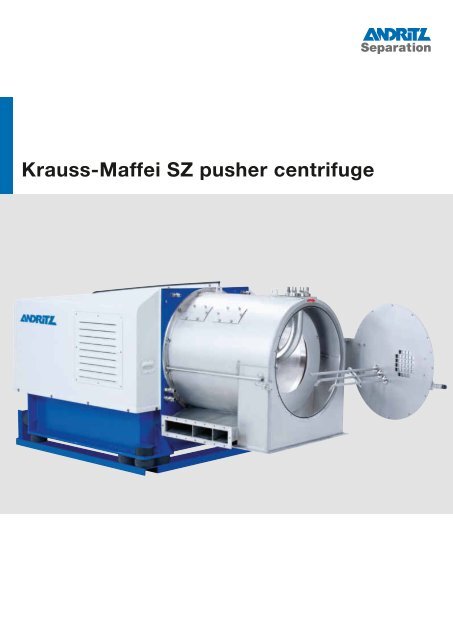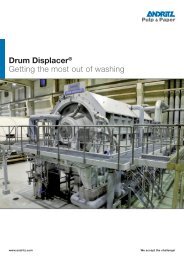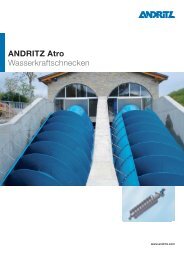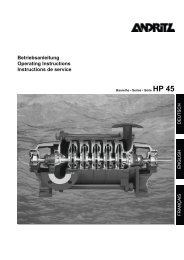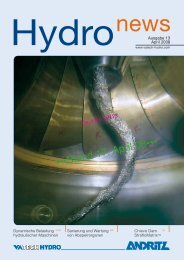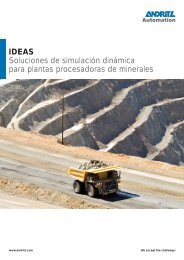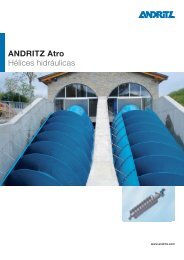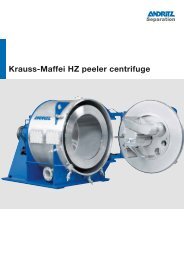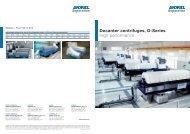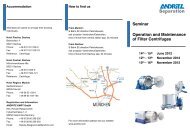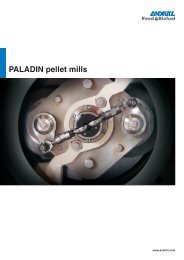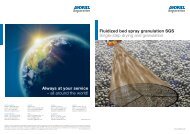Krauss-Maffei SZ pusher centrifuge - Andritz
Krauss-Maffei SZ pusher centrifuge - Andritz
Krauss-Maffei SZ pusher centrifuge - Andritz
Create successful ePaper yourself
Turn your PDF publications into a flip-book with our unique Google optimized e-Paper software.
<strong>Krauss</strong>-<strong>Maffei</strong> <strong>SZ</strong> <strong>pusher</strong> <strong>centrifuge</strong>
2<br />
<strong>Krauss</strong>-<strong>Maffei</strong> <strong>SZ</strong> <strong>pusher</strong> <strong>centrifuge</strong><br />
Table of contents<br />
<strong>Krauss</strong>-<strong>Maffei</strong> <strong>SZ</strong> <strong>pusher</strong> <strong>centrifuge</strong> 3<br />
Process advantages 4<br />
Designs and drives 5<br />
Operation 6<br />
Peripheral equipment 8<br />
Applications 9<br />
Foundation/installation 10<br />
Maintenance concept 10<br />
Dimensions and weights 11<br />
Process automation 12<br />
Services 13<br />
Company profile 14<br />
Product lines 15
<strong>Krauss</strong>-<strong>Maffei</strong> <strong>SZ</strong> <strong>pusher</strong> <strong>centrifuge</strong><br />
Maximum reliability<br />
In continuous solid/liquid separation<br />
<strong>Krauss</strong>-<strong>Maffei</strong> <strong>pusher</strong> <strong>centrifuge</strong>s<br />
combine the features of high availabil-<br />
ity with minimum maintenance and re-<br />
duced specific space requirement.<br />
They enable effective dewatering of fast fil-<br />
tering products with high throughput rates.<br />
The quality of the final product can be in-<br />
creased using a variety of washing modes.<br />
<strong>Krauss</strong>-<strong>Maffei</strong> <strong>pusher</strong> <strong>centrifuge</strong>s are applied<br />
in many fields of industry. Examples of<br />
these applications are to be found in bulk<br />
chemicals, plastics production, mining and<br />
minerals, the fiber industry and food processing.<br />
ANDRITZ KMPT boasts over<br />
80 years of experience with <strong>Krauss</strong>-<strong>Maffei</strong><br />
<strong>centrifuge</strong>s in over 5,000 installations across<br />
the globe.<br />
<strong>Krauss</strong>-<strong>Maffei</strong> <strong>pusher</strong> <strong>centrifuge</strong>, <strong>SZ</strong> 630<br />
Main applications<br />
■ Bulk chemicals<br />
(Borax/Boric acid, ferro sulphate,<br />
soda applications, sodium chlorate,<br />
sodium chloride, sodium sulphate)<br />
■ Agrochemicals<br />
(Ammonium chloride, ammonium sulphate,<br />
phosphates, potassium chloride,<br />
potassium sulphate, urea)<br />
■ Plastics<br />
(ABS, adipic acid, BPA, melamine,<br />
paraxylene, POM, sodium formiate)<br />
■ Foodstuffs<br />
(Lysine, phosphoric acid, sodiumhydrogen<br />
carbonate)<br />
Processing parameters<br />
Average particle size<br />
80-2,000 µm<br />
Solids content<br />
> 20% by wt.<br />
Solids throughput<br />
up to 150 t/h<br />
Solids recovery<br />
> 98%<br />
Solids concentration of slurry to be<br />
separated<br />
■ 30-75 M% for crystalline products<br />
■ 2-12 M% for fibrous products<br />
■ 5-25 M% for plastics<br />
Materials of construction<br />
■ Stainless steel<br />
3
4<br />
<strong>Krauss</strong>-<strong>Maffei</strong> <strong>SZ</strong> <strong>pusher</strong> <strong>centrifuge</strong><br />
Process advantages<br />
■ Low energy consumption<br />
More than 25% in energy savings compared<br />
to relevant competitors due to optimized<br />
design of process area and efficient <strong>pusher</strong><br />
system<br />
■ Outstanding product quality<br />
• Highly efficient cake washing modes.<br />
• Minimum particle breakage with optimized<br />
feed system.<br />
• Selection of screen configurations designed<br />
for your product parameters.<br />
<strong>Krauss</strong>-<strong>Maffei</strong> <strong>pusher</strong> <strong>centrifuge</strong>, <strong>SZ</strong> 1250<br />
■ Unmatched capacity<br />
• Welded or milled screens depending on<br />
application.<br />
• Highest <strong>pusher</strong> volume.<br />
• Different types of patented feed distributors.<br />
■ Superior maintenance concept<br />
• Innovative, ANDRITZ KMPT patented<br />
cartridge system provides minimum production<br />
downtime.<br />
• Optimized wear parts offer fast replacement.<br />
• Low screen wear by using vane type feed<br />
distributor.
<strong>Krauss</strong>-<strong>Maffei</strong> <strong>SZ</strong> <strong>pusher</strong> <strong>centrifuge</strong><br />
Designs and drives<br />
Hydraulic drive Mechanical drive with eccentric<br />
Drives for rotary and<br />
<strong>pusher</strong> action<br />
<strong>Krauss</strong>-<strong>Maffei</strong> <strong>pusher</strong> <strong>centrifuge</strong>s use<br />
two drives, one for the rotary motion<br />
and one for the oscillating <strong>pusher</strong> motion,<br />
and are controlled independently<br />
of each other.<br />
The rotary motor accelerates the empty<br />
rotor during the start-up process. During<br />
operation, the continuously fed product is<br />
accelerated in radial direction. The rotary<br />
drive is an axially parallel motor which drives<br />
the rotor via a V-belt. The <strong>pusher</strong> drive generates<br />
an oscillating motion by the <strong>pusher</strong><br />
element. Its task is to generate the axial, alternating<br />
<strong>pusher</strong> force and to control the<br />
movement process. The <strong>pusher</strong> drive can<br />
be of hydraulic or mechanical design.<br />
Hydraulic <strong>pusher</strong> drive<br />
Pusher <strong>centrifuge</strong>s with a hydraulic <strong>pusher</strong><br />
drive offer very high throughput rates based<br />
on their high <strong>pusher</strong> force and high G-force.<br />
Machine sizes with a basket diameter of<br />
630, 800, 1,000 and 1,250 mm are<br />
equipped with the hydraulic drive arrangement,<br />
which is optional for the machines<br />
with a basket diameter of 400 and 500 mm.<br />
The <strong>pusher</strong> motion is generated in machines<br />
with hydraulic drive by alternating admission<br />
of hydraulic oil to the rotating <strong>pusher</strong> cylinder.<br />
In this process the exact quantity of required<br />
oil is pre-accelerated. Compared<br />
to systems with bypass regulation, this is a<br />
benefit resulting from distinctly lower energy<br />
consumption with reduced cooling and<br />
drive outputs. The reciprocating motion is<br />
achieved by slide valves which can be actuated<br />
electrically, hydraulically or mechanically.<br />
The <strong>pusher</strong> frequency and stroke<br />
length can be adapted to the operating conditions<br />
while the machine is running.<br />
Mechanical <strong>pusher</strong> drive<br />
With the mechanical drive a worm screw is<br />
driven by a motor via a V-belt. An eccentric<br />
converts the rotary motion of the gear output<br />
shaft into a <strong>pusher</strong> motion. The <strong>pusher</strong><br />
frequency depends on the ratio of the V-belt<br />
drive of the motor to the worm gear.<br />
Pusher <strong>centrifuge</strong>s with a mechanical drive<br />
are extremely maintenance-friendly. This is<br />
because no significant maintenance work is<br />
required apart from recurrent lubrication of<br />
the bearings. The individual drive components<br />
can be replaced without disassembly<br />
of the <strong>centrifuge</strong>. A major advantage: the<br />
machine does not require cooling water.<br />
Machines with a basket diameter of 250,<br />
315, 400 and 500 mm are fitted with the<br />
mechanical drive concept.<br />
5
6<br />
<strong>Krauss</strong>-<strong>Maffei</strong> <strong>SZ</strong> <strong>pusher</strong> <strong>centrifuge</strong><br />
Operation<br />
Feeding Cake washing Vane-type feed distributor<br />
Function<br />
<strong>Krauss</strong>-<strong>Maffei</strong> <strong>pusher</strong> <strong>centrifuge</strong>s are continuously<br />
operating <strong>centrifuge</strong>s. The product<br />
is fed through a feed pipe (or feed screw in<br />
the case of products which do not flow<br />
freely) into the feed distributor which rotates<br />
with the basket. This accelerates the<br />
slurry and feeds it with uniform distribution<br />
to the feed zone, where the largest portion<br />
of the liquid (approx. 80%) is filtered. In the<br />
feed zone the solids grow to form a stable<br />
filter cake ring. The filter cake is conveyed in<br />
the direction of the solids discharge stroke<br />
by stroke due to the axial relative movement<br />
between <strong>pusher</strong> bottom and screen basket.<br />
During this process an intact filter cake<br />
forms over the entire length of the screen.<br />
As the filter cake progresses from the feed<br />
zone to the solids discharge it can undergo<br />
washing, as required. For this purpose a<br />
wash liquor is applied to the cake surface<br />
and displaces the suspension liquid and impurities.<br />
Multi-stage washing is also possible<br />
with several successive washing zones.<br />
Multi-stage <strong>centrifuge</strong>s with several baskets<br />
loosen the filter cake and reshape it by moving<br />
it from the inner basket to the next larger<br />
basket. As a result of this re-shaping<br />
process, moisture that forms between the<br />
particles is exposed and filtered. The solids<br />
are discharged at the end of the basket after<br />
each <strong>pusher</strong> movement.<br />
Feed conditions<br />
For machine size optimization and maximum<br />
operating reliability it is important to<br />
provide a uniform and concentrated slurry<br />
feed. As upstream equipment such as crystallizers<br />
or reactors frequently do not meet<br />
these requirements satisfactorily, a prethickener<br />
system is usually applied. This<br />
system levels out fluctuations in the feed<br />
conditions and minimizes the hydraulic load<br />
of the <strong>centrifuge</strong>. This can often lead to a<br />
smaller machine size being selected. Stationary<br />
or dynamic equipment have become<br />
established as pre-thickeners, depending<br />
on the type of application. Examples of stationary<br />
equipment are sedimentation tanks<br />
and thickener filters, examples of dynamic<br />
equipment include curved screens, hydrocyclones,<br />
vibration screens, and EC screen<br />
thickeners. In stationary thickeners, a metering<br />
unit is required to control the feed to<br />
the <strong>centrifuge</strong>, and in dynamic thickeners<br />
the feed to the thickener must be monitored.<br />
Feeding<br />
The feed system has the most significant<br />
impact on operation of the <strong>centrifuge</strong>. The<br />
ANDRITZ KMPT patented vane-type feed<br />
distributor has to pre-accelerate the slurry<br />
and distribute it uniformly in the feed zone<br />
in order to achieve uniform cake formation.<br />
Uniform distribution of the slurry is the<br />
basic requirement for trouble-free operation<br />
of the <strong>centrifuge</strong>.
<strong>Krauss</strong>-<strong>Maffei</strong> <strong>SZ</strong> <strong>pusher</strong> <strong>centrifuge</strong><br />
Operation<br />
Discharge Cleaning Special discharge design<br />
Vane-type feed distributor<br />
A special feature of <strong>Krauss</strong>-<strong>Maffei</strong> <strong>pusher</strong><br />
<strong>centrifuge</strong>s is the vane-type feed distributor.<br />
The slurry flow is diverted in the direction of<br />
rotation of the basket by the vane-type feed<br />
distributor. The slurry is pre-accelerated to<br />
such an extent that the difference between<br />
the speed of the slurry and the screen is<br />
practically zero. In this way, particle attrition<br />
is noticeably reduced in comparison with<br />
other feed systems. This results in more uniform<br />
formation of the filter cake and higher<br />
throughput rates. The machine is filled<br />
evenly and runs much more smoothly and<br />
quietly as a result. Benefits are obtained<br />
from reduced maintenance costs as a result<br />
of low wear.<br />
Filtration<br />
In addition to the pre-acceleration the residual<br />
moisture can be influenced by a variable<br />
residence time of the product in the <strong>centrifuge</strong>.<br />
The residence time is usually between<br />
10 and 60 seconds. It is mostly<br />
dependent on the adhesion factor between<br />
the product and the filter media. By changing<br />
the stroke frequency the residence time<br />
during the operation is optimized and adjusted<br />
to the actual throughput rates. There<br />
is a wide range of screens available for providing<br />
the optimum filter media for the variety<br />
of separating tasks. The width between<br />
the slots and the screen profile are optimally<br />
adjusted to the respective product. The slot<br />
widths of the screen generally range between<br />
0.1 and 0.5 mm.<br />
Discharge conditions<br />
The two flows of filtrate and solids are discharged<br />
separately from the machine. It is<br />
important that there is no congestion of the<br />
filtrate during this process. As the baskets<br />
have the effect of a fan, filtrate and vapor are<br />
frequently mixed, although vapor in the filtrate<br />
flow is not desirable in most cases. To<br />
avoid this, the filtrate flow is subjected to further<br />
separation in a degassing cyclone. The<br />
vapor is either fed back to the <strong>centrifuge</strong><br />
housing or discharged to a ventilation system.<br />
During solids discharge it is important<br />
that the product is ejected without product<br />
congestion or deposits. The solids discharge<br />
must be designed differently depending<br />
on the properties of the product.<br />
7
8<br />
<strong>Krauss</strong>-<strong>Maffei</strong> <strong>SZ</strong> <strong>pusher</strong> <strong>centrifuge</strong><br />
Peripheral equipment<br />
A <strong>pusher</strong> <strong>centrifuge</strong> requires stable<br />
feed conditions with solids concentrations<br />
in the feed slurry in the range of<br />
30-65% (by wt.) for crystalline products.<br />
Crystallization and evaporation systems are<br />
subject to operational variability. In order to<br />
stabilize the feed slurry from such systems,<br />
ANDRITZ KMPT offers several solutions for<br />
pre-concentrating the feed slurry.<br />
ANDRITZ KMPT can offer different<br />
systems:<br />
EC prethickener (1)<br />
A dynamic prethickener using a filter element<br />
to remove liquid and improve the feeding<br />
conditions to the <strong>centrifuge</strong>. This is an<br />
ANDRITZ KMPT development and is used<br />
for crystal and plastic material (examples:<br />
ammonium sulphate, PE).<br />
Bent screen (2)<br />
ANDRITZ KMPT bent screens are designed<br />
for gas-tight requirements (examples: adipic<br />
acid).<br />
This is mainly achieved with an additional,<br />
external unit which provides the most economical<br />
and safest solution. Internal preconcentration<br />
is an option, but is less<br />
flexible as it is limited to removal of liquid and<br />
has high power consumption due to acceleration<br />
of the entire slurry to the rotational<br />
speed.<br />
Suspension<br />
Filtrate<br />
Prethickened Suspension<br />
Wash Filtrate<br />
Solids<br />
1 2<br />
3<br />
Hydrocyclone (3)<br />
Suitable for all products with density differences<br />
(examples: soda application, salts).<br />
Static thickener (4)<br />
Also an ANDRITZ KMPT design, the static<br />
thickener is used to improve the feed conditions<br />
and achieve maximum feed solids<br />
concentration. This system uses the sedimentation<br />
effect. Liquid is removed by overflow<br />
and/or filtration elements. Feeding can<br />
be performed by an ANDRITZ KMPT feed<br />
system or an agitation outlet device combined<br />
with standard valves to control the<br />
flow (Examples: adipic acid, salts).<br />
4
<strong>Krauss</strong>-<strong>Maffei</strong> <strong>SZ</strong> <strong>pusher</strong> <strong>centrifuge</strong><br />
Applications<br />
Suspension<br />
Solids Filtrates<br />
The application spectrum of <strong>pusher</strong><br />
<strong>centrifuge</strong>s ranges from the processing<br />
of minerals to the dewatering of highly<br />
specialized plastics.<br />
Soda<br />
In the soda industry, <strong>pusher</strong> <strong>centrifuge</strong>s are<br />
used for dewatering of a wide range of<br />
sodium carbonate compounds. The process<br />
engineering requirements vary from product<br />
to product: Some products are sticky, with<br />
caking tendency, others require specific temperature<br />
control. Based on the experience<br />
gathered, ANDRITZ KMPT is able to provide<br />
tailor-made solutions. An example is the<br />
further dewatering of sodium hydrogen carbonate.<br />
The product has very specific characteristics.<br />
A feed screw ensures the<br />
continuous feed of the product. Basket and<br />
feed systems are optimally aligned to the<br />
process engineering requirements.<br />
Potash industry<br />
Pusher <strong>centrifuge</strong>s in the potash industry<br />
have to meet the following requirements:<br />
■ High wear resistance<br />
■ High throughput rate<br />
■ Low energy consumption<br />
Our experience in processing potash resulted<br />
in a unit with many special wear-resistant<br />
features, yielding longer operational<br />
life with minimal maintenance downtime.<br />
Adipic acid<br />
The requirements in dewatering of raw, pure<br />
and superpure adipic acid are:<br />
■ Protection of the operating personnel and<br />
the environment against nitrous gases.<br />
■ High level of purity of the final product.<br />
■ Protecting the particles against breakage.<br />
ANDRITZ KMPT <strong>pusher</strong> <strong>centrifuge</strong>s meet<br />
these demands by utilizing a gas-tight design<br />
housing, two-stage backwashing to<br />
achieve product purity, and gentle handling<br />
of the feed with our patented vane-type feed<br />
distributor.<br />
ABS<br />
Dewatering of ABS is a major application for<br />
<strong>Krauss</strong>-<strong>Maffei</strong> <strong>centrifuge</strong>s. In those applications<br />
with large particle sizes, <strong>pusher</strong><br />
<strong>centrifuge</strong>s offer many benefits:<br />
Soda production<br />
■ Gas-tight design and special gas control<br />
system minimize risk of dust explosion.<br />
■ High surface quality finishes to avoid<br />
plugging and caking of the product.<br />
■ Compliance with ATEX safety regulations<br />
for hazardous processes.<br />
Sodium chloride<br />
High product quality, low costs and high<br />
performance are requirements for processing<br />
bulk products such as sodium chloride.<br />
<strong>Krauss</strong>-<strong>Maffei</strong> <strong>pusher</strong> <strong>centrifuge</strong>s, with their<br />
continuous dewatering operation, meet<br />
these requirements all along the line. They<br />
are extremely reliable and feature high availability,<br />
as a result of the unique ANDRITZ<br />
KMPT maintenance concept.<br />
ABS, adipic acid, ammonium chloride,<br />
ammonium sulphate, BPA, urea, borax,<br />
calcium nitrate, ferro sulphate, lithium<br />
salts, lysine, melamine, nickel sulphate,<br />
paraxylene, PE, phosphate, POM,<br />
potassium chloride, potassium nitrate,<br />
potassium residue, potassium sulphate,<br />
sodium carbonate monohydrate,<br />
sodium chlorate, sodium chloride,<br />
sodium cyanide, sodium formiate<br />
9
10<br />
<strong>Krauss</strong>-<strong>Maffei</strong> <strong>SZ</strong> <strong>pusher</strong> <strong>centrifuge</strong><br />
Foundation/installation<br />
Arrangement/foundation<br />
The centrifugal forces produced by the rotation<br />
of the basket are used to separate the<br />
solids from the liquid. If the product is not<br />
uniformly distributed into the <strong>centrifuge</strong> basket<br />
imbalance may develop. To keep the dynamic<br />
loads exerted on a building to a<br />
minimum vibration-insulated installations are<br />
used. This is implemented by installing the<br />
<strong>centrifuge</strong> on a concrete or steel block<br />
which is mounted on spring-damper elements.<br />
Important guidelines<br />
■ Feed pressure should be ~0.5 bar.<br />
■ Supply pipes as short as possible.<br />
■ Install all supply and discharge pipes<br />
with a maximum gradient.<br />
■ All connections to the <strong>centrifuge</strong> must<br />
be flexible.<br />
<strong>Krauss</strong>-<strong>Maffei</strong> <strong>pusher</strong> <strong>centrifuge</strong> <strong>SZ</strong> 1000 with cartridge<br />
Maintenance concept<br />
Maximum availability<br />
In <strong>pusher</strong> <strong>centrifuge</strong>s with hydraulic <strong>pusher</strong><br />
drive the basket, shaft, bearing, <strong>pusher</strong> drive<br />
and a part of the rear wall combine to form<br />
one unit – referred to as the KMPT patented<br />
cartridge. This cartridge can be completely<br />
removed in one piece with very little effort.<br />
After reinstalling a spare cartridge all maintenance<br />
work on the rotating elements can<br />
be carried out in the workshop area without<br />
being under any time pressure. In this way,<br />
downtimes are reduced to a minimum. All<br />
connections are on the process housing<br />
and do not have to be removed for maintenance<br />
work. For <strong>pusher</strong> <strong>centrifuge</strong>s with<br />
mechanical drives no significant maintenance<br />
is required apart from recurrent lubri-<br />
cation of the bearings. Large inspection<br />
openings and a large door to the process<br />
area facilitate access for inspection, maintenance<br />
and cleaning work.
<strong>Krauss</strong>-<strong>Maffei</strong> <strong>SZ</strong> <strong>pusher</strong> <strong>centrifuge</strong><br />
Dimensions and weights<br />
Model Nominal L l W H Operating Pusher<br />
diameter weight drive<br />
[mm] [mm] [mm] [mm] [mm] [kg]<br />
<strong>SZ</strong> 250 250 1,750 1,000 1,150 970 1,000 Eccentric<br />
<strong>SZ</strong> 315 315 1,910 1,100 1,250 1,000 1,350 Eccentric<br />
<strong>SZ</strong> 400 400 2,350 1,400 1,440 1,340 2,300 Eccentric<br />
<strong>SZ</strong> 500 500 2,870 1,770 1,,530 1,130 3,350 Eccentric<br />
<strong>SZ</strong> 400 400 2,380 1,570 1,470 1,350 3,500 Hydraulic<br />
<strong>SZ</strong> 500 500 2,530 1,570 1,470 1,350 3,700 Hydraulic<br />
<strong>SZ</strong> 630 630 3,000 1,780 1,620 1,530 5,300 Hydraulic<br />
<strong>SZ</strong> 800 800 3,410 2,070 1,950 1,770 8,400 Hydraulic<br />
<strong>SZ</strong> 1000 1,000 4,060 2,530 2,190 1,950 13,300 Hydraulic<br />
<strong>SZ</strong> 1250 1,250 4,950 4,000 2,490 2,060 19,500 Hydraulic<br />
Machines are designed with 1, 2 or multiple stages, depending on the application.<br />
All technical data are approximate and subject to change without notice.<br />
L<br />
l<br />
H<br />
W<br />
11
12<br />
<strong>Krauss</strong>-<strong>Maffei</strong> <strong>SZ</strong> <strong>pusher</strong> <strong>centrifuge</strong><br />
Process automation<br />
Perfection in process engineering requires<br />
perfection in process automation.<br />
The superior performance of our process<br />
equipment is based on perfecting the interface<br />
between equipment hardware, electrical<br />
components, electronics, informatics,<br />
and process know-how to create an all-encompassing<br />
custom-tailored solution for<br />
each application. Using intelligent sensors<br />
and state-of-the-art communication systems,<br />
we control and monitor our machines<br />
on a result-oriented basis.<br />
The benefits of our process automation are:<br />
■ Enhanced equipment performance<br />
■ Consistent high product quality<br />
■ Reduced consumption of utilities<br />
■ Optional condition diagnostics<br />
Automation of machines<br />
Individual adaptation – we can incorporate<br />
the automation concepts for our machine<br />
into your existing control system.<br />
A modular controls concept enables the automization<br />
of single units up to complex<br />
control systems in existing plants. PLC,<br />
PLC-Failsafe and discrete technologies, including<br />
the required visualization, are used<br />
to display important information on plant<br />
and machinery. State-of-the-art technology<br />
enables ANDRITZ KMPT to provide remote<br />
maintenance of your automation equipment<br />
- subject to your approval.<br />
ANDRITZ KMPT offers variable drive systems,<br />
which provide the following benefits:<br />
■ Optimized adjustment of machine to<br />
process.<br />
■ Reduced operating costs due to energysaving<br />
drives.<br />
Safety features and equipment<br />
A reliable machine protects operating personnel<br />
and equipment. Machinery directives,<br />
ATEX, hazardous location regulations<br />
– there are many regulations to be obeyed<br />
at the plant site. ANDRITZ KMPT serves<br />
as your knowledgeable advisor for your<br />
plant. Of particular importance are safe<br />
actual speed values, deadlock and over<br />
speed monitoring, door locking, belt<br />
slippage, and safe inertisation.<br />
ANDRITZ KMPT process<br />
automation reduces investment,<br />
operation and maintenance costs.
ANDRITZ KMPT<br />
Services<br />
Refurbished equipment Commissioning Spare parts<br />
Our goal is to provide our customers<br />
with fast and reliable service, from the<br />
first process consultation throughout<br />
the entire service life of your ANDRITZ<br />
KMPT process equipment.<br />
To assist our global customer base, we op-<br />
erate service facilities around the world<br />
staffed with experienced, dedicated service<br />
teams.<br />
Spare parts<br />
We keep over 6,000 different spare parts<br />
and components in stock for you. Our service<br />
centers in the USA, the UK, Italy,<br />
France, and China, for example, maintain<br />
their own spare parts stock to enable<br />
faster delivery to your plant site.<br />
Reconditioned units<br />
We maintain a select stock of reconditioned<br />
units available for fast delivery from our facility.<br />
All machines are fully disassembled, inspected<br />
and reconditioned by replacing<br />
worn or damaged parts. A final test run validates<br />
the mechanical guarantee we provide<br />
with our refurbished equipment. With our<br />
factory reconditioned units you gain production<br />
capacity quickly with minimal capital investment.<br />
Repairs and maintenance<br />
Our service centers are ready to provide you<br />
with regularly scheduled maintenance or<br />
emergency service at your site. Our experts<br />
provide assistance including assembly<br />
work, installation support, commissioning,<br />
upgrades, repair work, and optimization of<br />
your process conditions.<br />
Advisory service<br />
Our customer service team is ready to answer<br />
any question concerning machine<br />
safety, equipment upgrades, and process<br />
optimization.<br />
Installation and commissioning<br />
Our experienced service personnel assists<br />
you with the installation and start-up of your<br />
equipment.<br />
Remote diagnostics<br />
Using modern communications and diagnostic<br />
systems, our customer service is able<br />
to offer even faster and more efficient support.<br />
Via remote access our specialists receive<br />
information on the operating condition<br />
of your machine and carry out fault diagnoses.<br />
Maximum data security is of course<br />
guaranteed at all times. We only access the<br />
data from your machine when you give your<br />
specific approval for us to do so.<br />
24-hour on-call service<br />
You can reach our skilled and experienced<br />
service team around the clock.<br />
Maintenance contracts<br />
We offer you tailor-made, long-term contracts<br />
for preventive maintenance of your<br />
equipment.<br />
Customer training<br />
We train your operating personnel during<br />
commissioning of the plant. In addition, we<br />
also offer you seminars for maintenance and<br />
operation of our entire line of process equipment.<br />
This training can be conducted at our<br />
site or yours.<br />
13
14<br />
ANDRITZ KMPT<br />
Company profile<br />
The ANDRITZ GROUP<br />
The ANDRITZ GROUP is a globally leading<br />
supplier of plants and services for the hydropower,<br />
pulp and paper, metals, and<br />
other specialized industries. The Group is<br />
headquartered in Graz, Austria, and has a<br />
staff of approximately 16,100 employees<br />
worldwide. ANDRITZ operates over 120<br />
production sites, service, and sales companies<br />
all around the world.<br />
ANDRITZ SEPARATION<br />
ANDRITZ SEPARATION is one of the leading<br />
global suppliers of plants, equipment,<br />
and services for mechanical and thermal<br />
solid/liquid separation (coal, ore and mineral<br />
processing, chemical, petrochemical, and<br />
food industries). The business area’s field of<br />
activity covers design and manufacture of<br />
key components (<strong>centrifuge</strong>s, filter presses,<br />
rotating filters, drying plants), as well as<br />
erection and start-up of turnkey plants, including<br />
automation, safety engineering, and<br />
services.<br />
ANDRITZ KMPT<br />
ANDRITZ KMPT has been a world leader<br />
and innovator in the chemical process industry<br />
for over 75 years. The extensive experience<br />
of our engineers comes from<br />
testing more than 3,000 products and putting<br />
over 9,000 applications to work. Over<br />
500 patents demonstrate our capacity for<br />
innovation. This extensive knowledge governs<br />
our process and equipment recommendations,<br />
all tailored to meet our<br />
customers’ requirements with an optimum<br />
in performance and cost.
ANDRITZ KMPT<br />
Product lines<br />
■ <strong>Krauss</strong>-<strong>Maffei</strong> <strong>centrifuge</strong>s<br />
With horizontal peeler <strong>centrifuge</strong>s known for<br />
reliability, pharma <strong>centrifuge</strong>s designed to<br />
meet highest quality standards, innovative<br />
vertical basket <strong>centrifuge</strong>s and continuously<br />
operating <strong>pusher</strong> <strong>centrifuge</strong>s, ANDRITZ<br />
KMPT has the capability to handle a broad<br />
range of separation applications in the<br />
chemicals, pharmaceuticals and environmental<br />
industries.<br />
■ <strong>Krauss</strong>-<strong>Maffei</strong> filters<br />
For vacuum or pressure filtration, our rotary<br />
drum and disc filters combine high yield with<br />
low production costs in the processing of<br />
chemicals, plastics and minerals.<br />
■ <strong>Krauss</strong>-<strong>Maffei</strong> dryers<br />
Batch drying in our conical mixer dryer with<br />
helical mixing assembly or continuous drying<br />
of free-flowing materials in our plate dryer –<br />
we offer the right choice of dryers for fine<br />
chemical and pharmaceutical producers.<br />
■ ANDRITZ KMPT process systems<br />
We apply our experience and expertise to<br />
create fully functional processing modules<br />
including peripherals and automation, saving<br />
the customer from having to deal with<br />
multiple vendors. ANDRITZ KMPT provides<br />
all the detailed engineering and reduces installation<br />
time with pre-assembled systems.<br />
15
ANDRITZ stands for ultimate know-how in<br />
solid/liquid separation. Our decade-long<br />
background in this field and comprehen-<br />
sive technology offering enable us to supply<br />
our customers with the best solution<br />
for each application, whether in municipal or<br />
industrial sewage sludge treatment, the<br />
chemical or food industry, or for prepara-<br />
tion of minerals and ores.<br />
Minerals<br />
ANDRITZ KMPT GmbH<br />
Industriestrasse 1-3<br />
85256 Vierkirchen, Germany<br />
Phone: +49 (0)8139 80299 - 0<br />
kmpt@andritz.com<br />
Food Chemicals<br />
Mining Environment<br />
ANDRITZ AG<br />
Stattegger Strasse 18<br />
8045 Graz, Austria<br />
Phone: +43 (316) 6902 0<br />
separation@andritz.com<br />
www.andritz.com<br />
All data, information, statements, photographs and graphic illustrations made in this leaflet are without any obligation and raise no liabilities to or form part of any sales contracts of<br />
ANDRITZ AG or any affiliates for equipment and/or systems referred to herein. © ANDRITZ AG 2011. All rights reserved. No part of this copyrighted work may be reproduced, modified<br />
or distributed in any form or by any means, or stored in any database or retrieval system, without the prior written permission of ANDRITZ AG or its affiliates. Any such unauthorized use<br />
for any purpose is a violation of the relevant copyright laws. ANDRITZ AG, Stattegger Strasse 18, 8045 Graz, Austria <strong>SZ</strong>-EN-04_11


